
 Korea:
A Treasure Trove of Natural and Cultural Beauty
Korea:
A Treasure Trove of Natural and Cultural Beauty
Words and pictures by Roderick Eime
When stacked up against regional tourism powerhouses like Japan and China, Korea is often not considered a contender. Yet on closer inspection, any visitor will discover a rich, historic culture quite distinct from its neighbours.
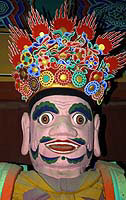
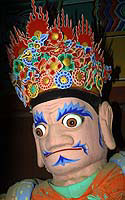 Today
we know Korea as a major industrial player on the global economic stage.
Korean brands like Samsung, Hyundai and LG are well known around
the globe and serve as shining beacons to consumers wanting high quality,
reliable electronic and mechanical goods. But beneath the bright neon
and Perspex signs proclaiming the superiority of Korean manufacturing,
dwells a gentle, conscientious people honourably striving to reinforce
their nation's enviable economic position.
Today
we know Korea as a major industrial player on the global economic stage.
Korean brands like Samsung, Hyundai and LG are well known around
the globe and serve as shining beacons to consumers wanting high quality,
reliable electronic and mechanical goods. But beneath the bright neon
and Perspex signs proclaiming the superiority of Korean manufacturing,
dwells a gentle, conscientious people honourably striving to reinforce
their nation's enviable economic position.
Outside of the bustling metropolises of Seoul and Pusan one can find quaint rural villages still practising age-old agricultural traditions and religious rites. Skilled artisans and gifted musicians add colour and verve to the landscape reminding you that Korea can produce far more than just whitegoods and cell phones.
The city of Gyeongju in the country's southeast province of Gyeongsangbuk-do, is a popular tourist and convention region with expansive parklands, lakes and gardens and, as the country's ancient capital, is host to many historic structures including several UNESCO World Heritage sites. The city regularly stages world standard events and recently played host to the World Culture Expo featuring, not only the rich Korean culture, but others from around the immediate Asian region and the world.
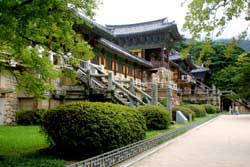 |
| Bulguksa, the Temple of the Land Buddha, sits mid-slope on Mt. Tohamsan. Its construction was completed under the supervision of Prime Minister Kim Dae-seong in the 10th year of King Gyeongdeok of the Silla Kingdom (751 AD). |
Regular travellers throughout Asia cannot help but be impressed by the magnificent architecture so typified by the imposing Bulguksa Temple complex located in the lush green valley near Mt Tohamsan. Designated by UNESCO as World Heritage in 1995 along with the neighbouring Seokguram Grotto, the temple attracts many thousands of visitors every year. Drawing both devout Buddhists and admirers of ancient architecture, the thousand year old temple is a fitting monument to the culturally advanced Silla Dynasty whose influences are seen widely throughout the region and even as far afield as Japan.
 Moving
north by road you are reminded of the rugged terrain that is both daunting
and beautiful at the same time. Modern highways deliver their traffic
quickly and efficiently along the country's major routes with minimal
impediment from the undulating countryside. South Korea is a modern,
highly mechanised country and most vehicles are either new or just a
few years old. Smokey old rattletraps are few and far between and tourist
coaches are of the highest standard.
Moving
north by road you are reminded of the rugged terrain that is both daunting
and beautiful at the same time. Modern highways deliver their traffic
quickly and efficiently along the country's major routes with minimal
impediment from the undulating countryside. South Korea is a modern,
highly mechanised country and most vehicles are either new or just a
few years old. Smokey old rattletraps are few and far between and tourist
coaches are of the highest standard.
Some three hundred kilometres by road from Gyeongju is the seaside city of Gangneung, attractively located between the Mt Odaesan National Park and the Sea of Japan. Watersports and beach recreation unfortunately becomes more difficult as you move further north towards the Demarcation Line, as security measures mean many of those beaches are out-of-bounds. As a reminder, a captured North Korean submarine is on display along with other items in the Unification Park. Consequently Gangneung enjoys a resort and tourist lifestyle offering may of the trappings like paragliding, scuba diving, horse-riding, bungee jumping, bushwalking and even hosts a Summer Beach Arts Festival in August.
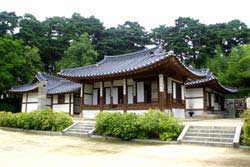 |
| Ojukheon,
the birthplace of Yi Yul-gok. This is one of the Korea’s oldest existing houses, built in the period of King Jungjong (1506–1544), in Gangneung, Gangwon-do. Yi Yul-gok was a great politician and scholar of the Joseon Period. He was born in this house and lived there with his mother Sinsaimdang, who was one of the finest artists of the Joseon period and a top scholar in her own right. |
Gangneung also hosts a number of Korea's National Treasures, all of which are conveniently numbered for easy identification. The highly significant Seongyojang Residence provides a cultural focus as one of the few remaining from the Joseon Dynasty with construction taking place, in the main, from the mid-18th century. Nearby at Ojukheon is National Treasure 165 which doubles as a museum exhibiting natural history, archaeology, literature, folklore life, calligraphy and paintings, donated artefacts and outdoor exhibits.
 Committed
adventurers also have the opportunity, thanks to an innovative and daring
tourism initiative, to visit some of the most startling mountainous
countryside just over the demarcation line in Communist North Korea.
Most commonly by special ferry, but also occasionally by bus, tourists
can travel to the specially set aside area within North Korea known
as Geumgangsan.
Committed
adventurers also have the opportunity, thanks to an innovative and daring
tourism initiative, to visit some of the most startling mountainous
countryside just over the demarcation line in Communist North Korea.
Most commonly by special ferry, but also occasionally by bus, tourists
can travel to the specially set aside area within North Korea known
as Geumgangsan.
Currently this enclosed area is mainly visited by South Koreans who have been denied access to this culturally significant and scenically stunning region because of the separation of the two Koreas. Contact with regular North Koreans is however impossible, as your movement is strictly but politely controlled. Nevertheless, their modest rural villages are visible from the buses and the celebrated Pyongyang Circus performs at the hotel complex.
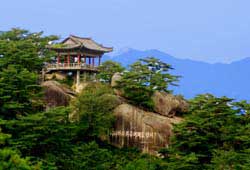 |
| A temple is perched high on an outcrop overlooking the scenic Lake Semilpo in the Haegeumgang (Kumgang) area of North Korea. This area was first opened to tourists in November 1998 and is visited by many South Koreans. |
Hiking is strenuous through the steep mountain passes of the Diamond Mountains, home to the romantic legend of the Heavenly Fairy and the Woodcutter. It is easy to imagine how this breathtaking scenery is the source of so many fables and folklore. It is also within the imagination of any visitor to conceive of the eventual reunification of the two Koreas, such is the desire of the ordinary people. If the beauty and serenity of the Geumpang Mountains serve as a symbol of unity, then it would be fitting that Mother Nature should soften the hardened hearts and pave a way for the peace-loving people of Korea to be together again as one.

 More
Information:
More
Information:
Korea Tourism www.tour2korea.com
 GET
BEST RATES FOR SOUTH KOREA HOTELS GET
BEST RATES FOR SOUTH KOREA HOTELS |
|
|
|
Background Image by Runic Design